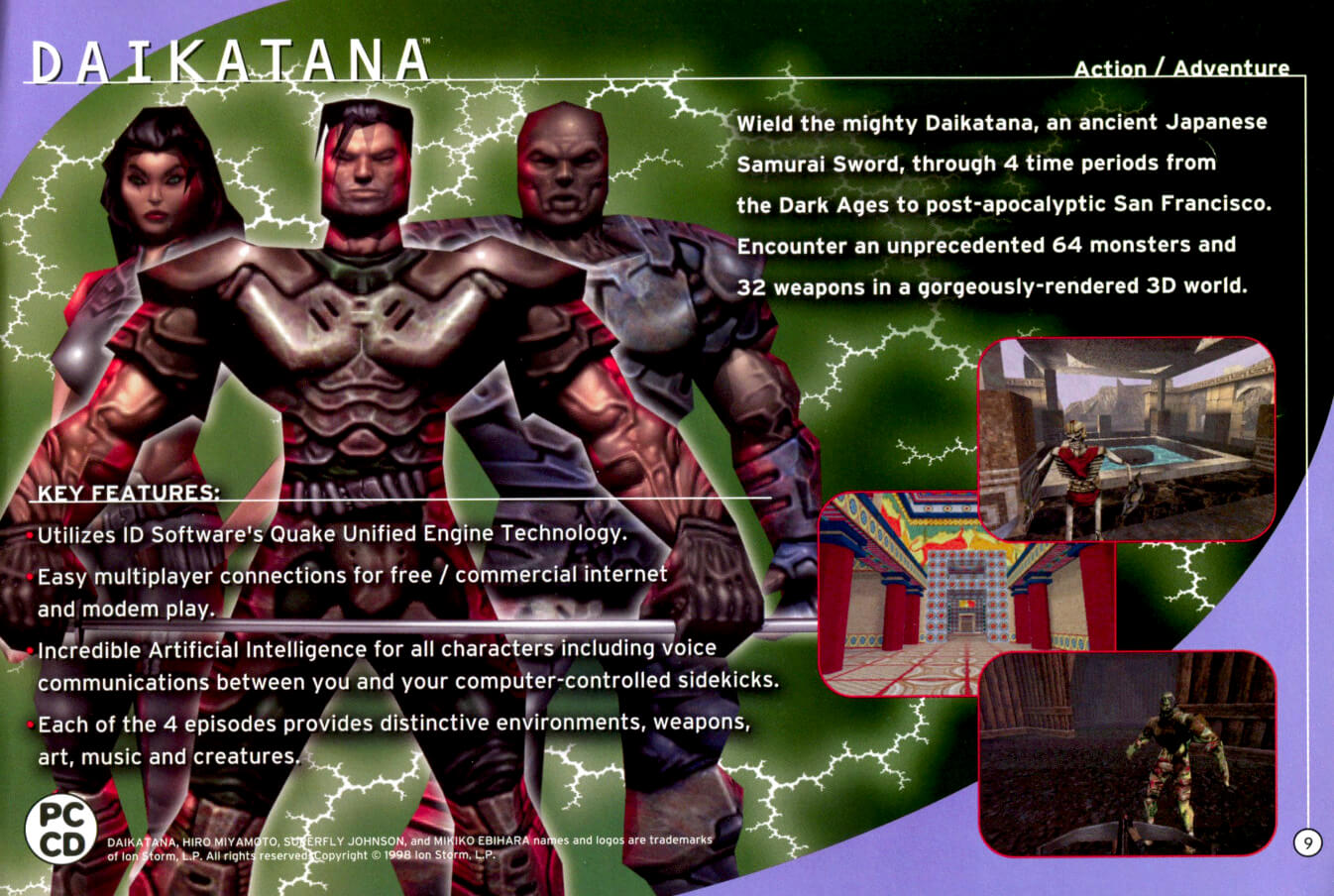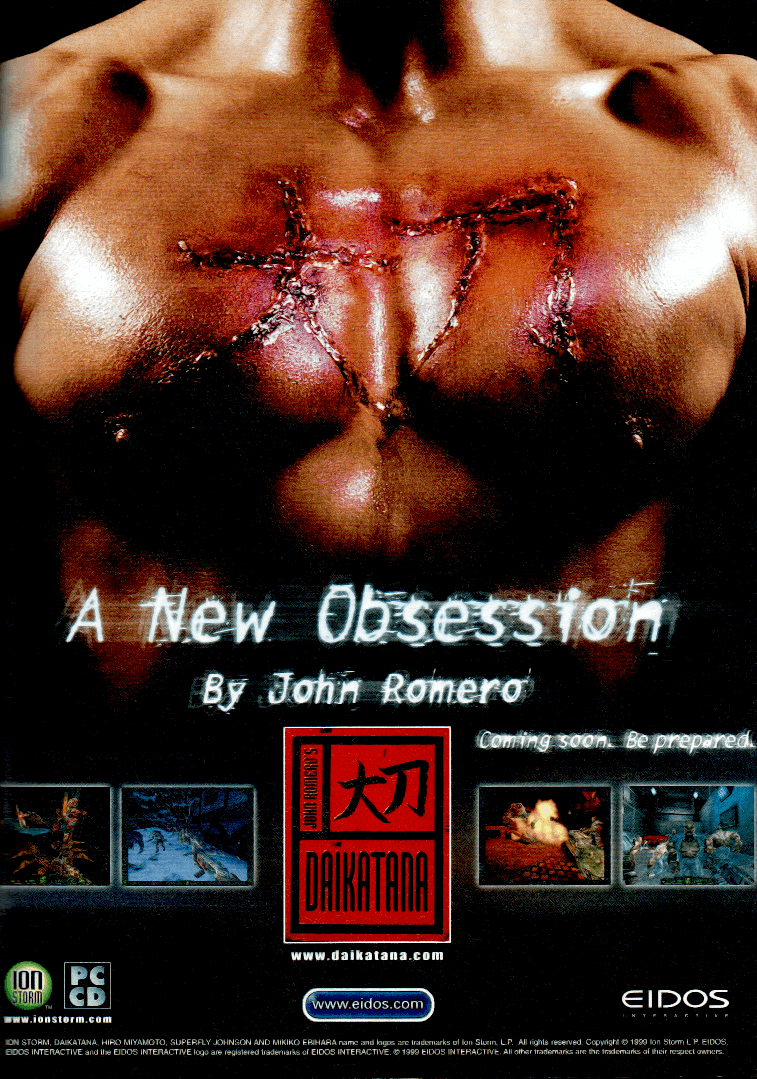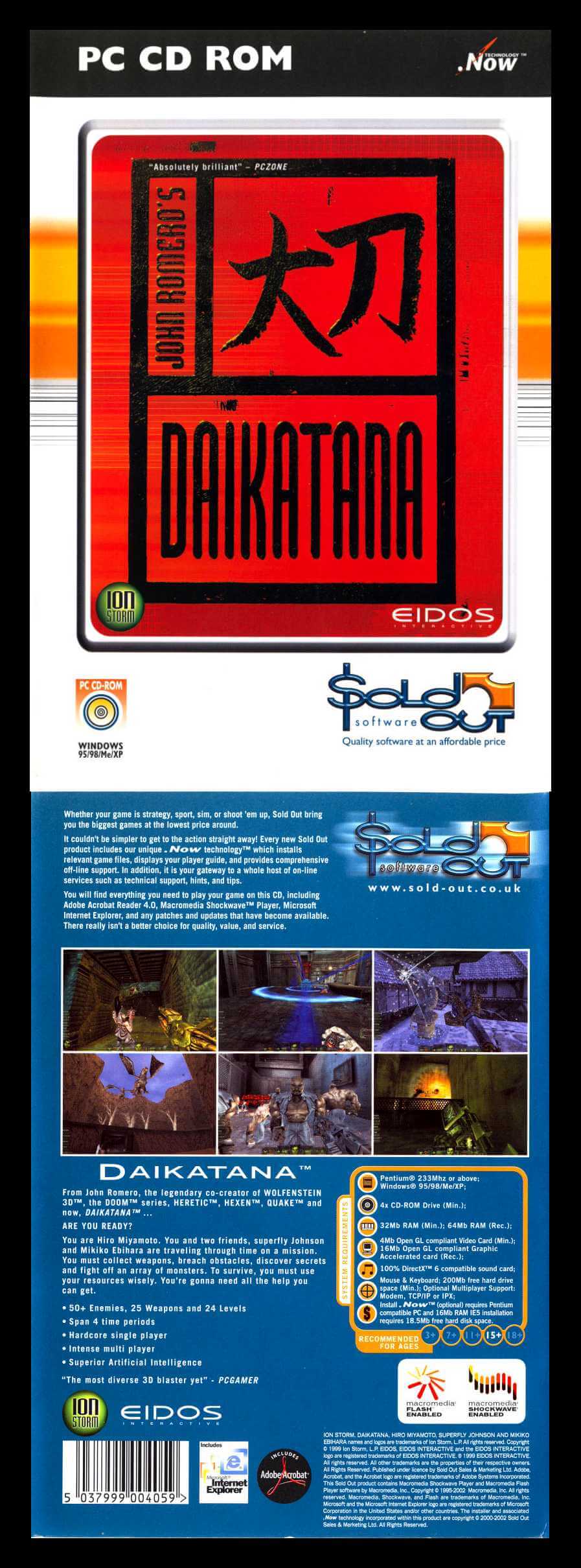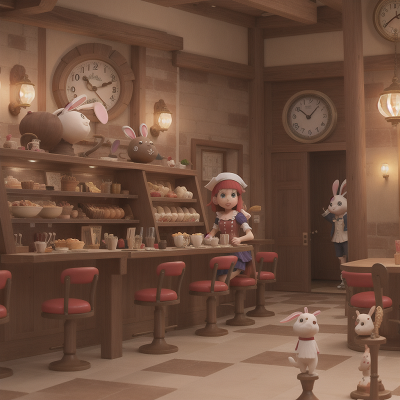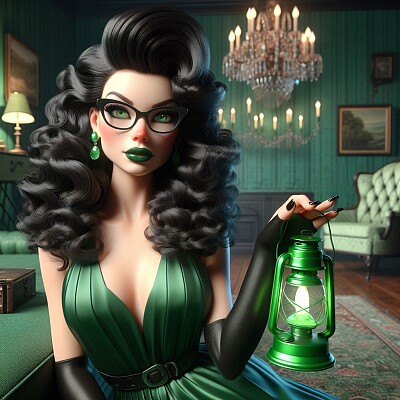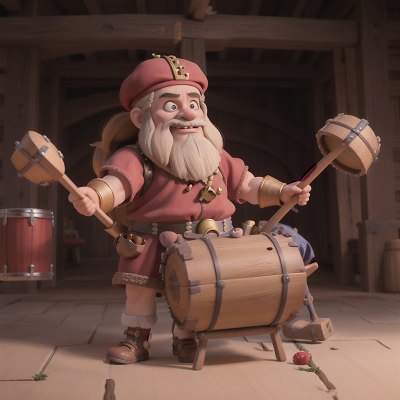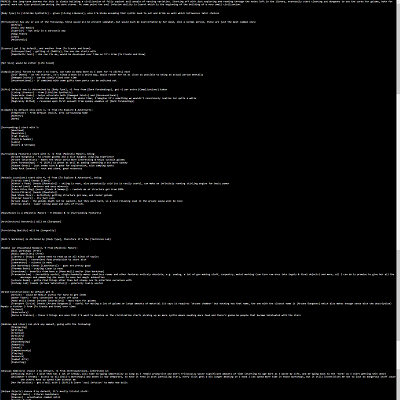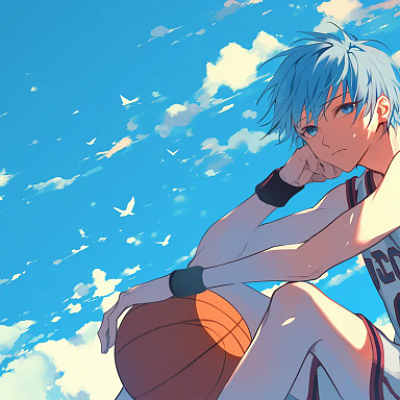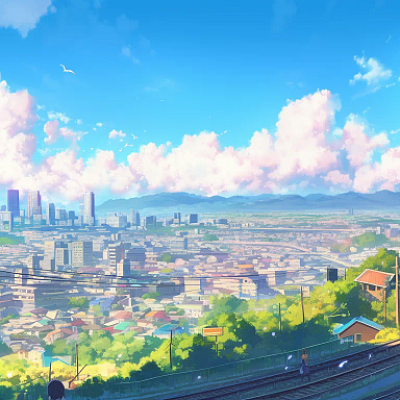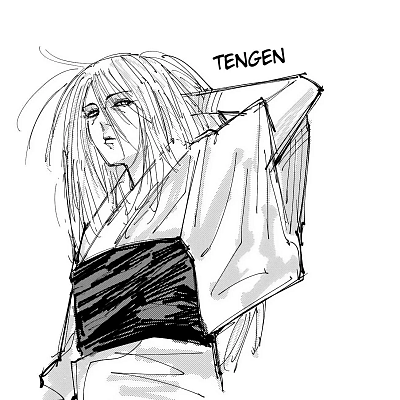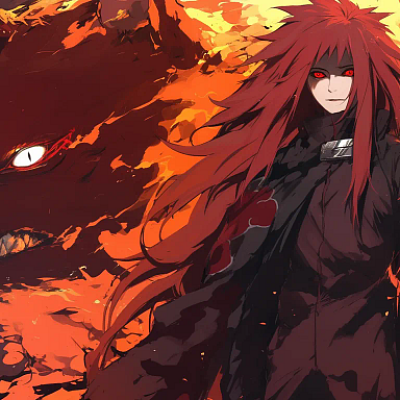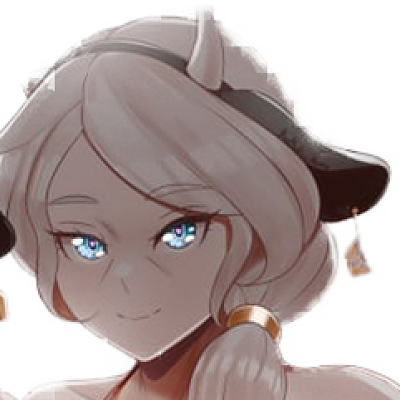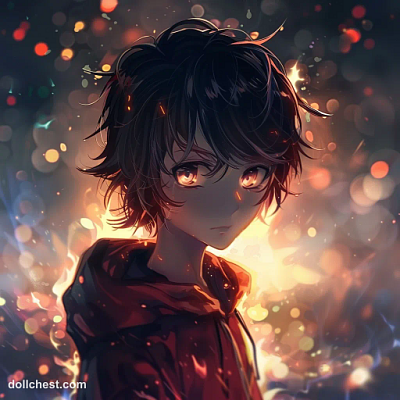Daikatana - Video game From The Late 90's
4 years ago • 6,803 Views • 5 Files
Description
John Romero's Daikatana is a first-person shooter using the Quake II engine. The game is divided into four episodes of several levels each, each episode taking place in a different time period: far-future Japan, ancient Greece, Dark Ages Norway, and near-future USA. The game uses cutscenes and text to tell the story. Two AI-controlled characters accompany Hiro throughout the quest, helping him in battles and also requiring protection. In addition to several different firearms, the Daikatana itself, which the player acquires in Episode 2, can gain experience and grow stronger as it is used. The game includes a multi-player deathmatch mode.
Story
Hiro Miyamoto is a martial arts instructor and a member of an ancient clan of fighters. One day he learns that Kage Mishima, a sworn enemy of his clan, has gained possession of the Daikatana, a magical sword that allows its bearer to travel through time. As a result of Mishima's quest for power, a devastating disease is threatening humanity. Hiro and his friends must venture into different time periods, retrieve the sword, and defeat Mishima.
Development
Daikatana was in development for 3 years, exactly. The reason for the long development cycle was the switch to the Quake II engine. Romero decided to switch because of its colored lighting, among other graphical goodies, but when he finally received the source code, it was nothing like he pictured. Overall the story of the game's development and Ion Storm in general is as epic and profound as anything in the game.
The game was built using the original Quake game engine; according to an early interview, Romero planned Daikatana to have unique weapon sets and 16 monsters per time period. The core concept was to do something different with shooter mechanics several times within the same game.[6] Romero created the basic storyline, and named its protagonist Hiro Miyamoto in honour of Japanese game designer Shigeru Miyamoto. The title is written in Japanese kanji, translating roughly to "big sword". The name comes from an item in a Dungeons & Dragons campaign played by the original members of id Software, which Romero co-founded.
During this early period, the team consisted of fifteen people. The music was composed by a team which included Will Loconto. However, during its earlier production, the team saw the Quake II engine and decided to incorporate its code. This resulted in many delays when finalising the engine. The problems with programming the new engine contributed to the game being delayed from its projected 1998 release date.[5] Romero stated prior to release that he would have chosen the Quake II engine to develop the game from the start if given the chance.
Romero later ascribed some problems triggered in using the technology as being due to the rivalry manufactured by the company's marketing between them and id Software. Due to the delays, development of the game ran parallel to Anachronox, Dominion: Storm Over Gift 3, and eventually Deus Ex.
Something that further impacted production was the departure of around twenty staff members from the team, who either left Ion Storm or transferred to the Austin studio. In 1998, lead artist Bryan Pritchard left the company and was replaced by Eric Smith. According to staff member Chrstian Divine, the growing negative press surrounding the company had a further detrimental effect on development. Some of the backlash eventually led to his own departure for Ion Storm's Austin studio to work on Deus Ex.
The most notorious incident was the public resignation of nine core team members at once, something Romero understood given the low team morale but felt it as a betrayal of trust. The departures led to the hiring of Stevie Case as level designer and Chris Perna to polish and add to character models. In a 1999 interview, Romero attributed the slowing of development during that period to the staff departures, but said that most of the level design and the entire score had been completed before that. Problems reached the point that Eidos publishing director John Kavanagh was sent down to sort out problems surrounding it production.
In a later interview, Romero admitted there were many faults with the game at release, blaming the development culture and management clashes at Ion Storm, in addition to staff departures causing much of the work to be scrapped and begun over again. Divine attributed the problems to a combination of overly carefree atmosphere, and corporate struggles about company ownership interfering with game production. Only two staff members remained on the game for the entirety of its production.
Advertisement
Long before Daikatana was released, an ad for it was was run in several magazines stating "John Romero's Gonna Make You His Bitch." Needless to say this upset quite a few folks.
Daikatana Deathmatch
In April 2007, a fan team released Daikatana Deathmatch (DKDM), a multiplayer-only modification stripping the game from all the single player parts to reduce the file size for players who only want the multiplayer part. It still requires a full copy of the game to play. The link can be found in the related links section.
Dialogue
The characters' sound files used in this game are not encrypted in any way. They're ordinary mp3 files which can be found in the data/sounds/voices folder of the Daikatana directory. There's quite a bit of unused dialogue in there which never made it into the full game. It seems the enemies and the player's two sidekicks were supposed to have more ambient dialogue (e.g. combat taunts, waiting sounds) than what was eventually used.
Dopefish
There are four Dopefish hidden in the game, one per time period.
German Windows version
In the German version enemy blood was colored grey, gore effects were removed and various human enemy modes changed, e.g. into robots or with an added mask to hide their face. A detailed list of changes can be found on schnittberichte.com (German).
Nintendo 64 version
The Nintendo 64 version misses violence in comparison to the original Windows version, e.g. purple instead of red blood. The PAL version was even cut further: the blood was replaced with sparks and civilians are immortal.
References
In the lobby of the Mishima Funeral Home/Crematorium, there's some solemn funeral-type music playing. This is really a slowed down version of the famous e1m1 music from DOOM.
Remix
As the sounds and dialog are not encrypted, one creative mixer was able to rearrange the dialog, add a little fake stuff here and there, add some bump-and-grind music, and came up with a long MP3 that sounds as if the two guys in the game were "engaging" the female sidekick. Computer Gaming World called it "the ONLY redeeming feature of Daikatana".
Promotion and release
The game was demoed at the 1999 Electronic Entertainment Expo. The demo ran at a very low frame rate, which further damaged the game's public image. Staff member Jake Hughes remembered that Romero wanted changes made which crippled the demo tech and caused the issues, while Romero states that he had already departed for E3 and the upper management insisted on the changes when he was gone.
On April 21, 2000, Daikatana was completed and reached gold status. A tie-in comic book was drawn by Marc Silvestri and released by Top Cow for Prima Games' Daikatana: Prima's Official Strategy Guide. The Nintendo 64 version was first released as a Blockbuster rental exclusive by Kemco. It was later released for retail on November 26, 2000.
Daikatana's final patch, version 1.2, was released on September 29, 2000. Lacking any further official support after the closure of Ion Storm's Dallas office in 2001, John Romero gave the game's source code to community members, allowing them to develop additional platform ports (most notably Linux, macOS and other Unix-like systems) and bug fixes. Following its release and the completion of Anachronox, it was decided by the Austin branch to close the Dallas branch.
Game Boy Color version
The Game Boy Color version of Daikatana was only released in Europe; Kemco decided against the North American and Japanese release due to the poor reputation of the Daikatana brand. This version's gameplay differs greatly from the N64 and PC versions: at Romero's request, the title was adapted to the platform as a top-down dungeon crawler, in the style of early Zelda games such as the NES original and The Legend of Zelda: Link's Awakening.
In 2004, Romero released the ROM images for the Game Boy Color game on his website, for use with emulators. Frank Provo for GameSpot gave the game a seven out of ten.
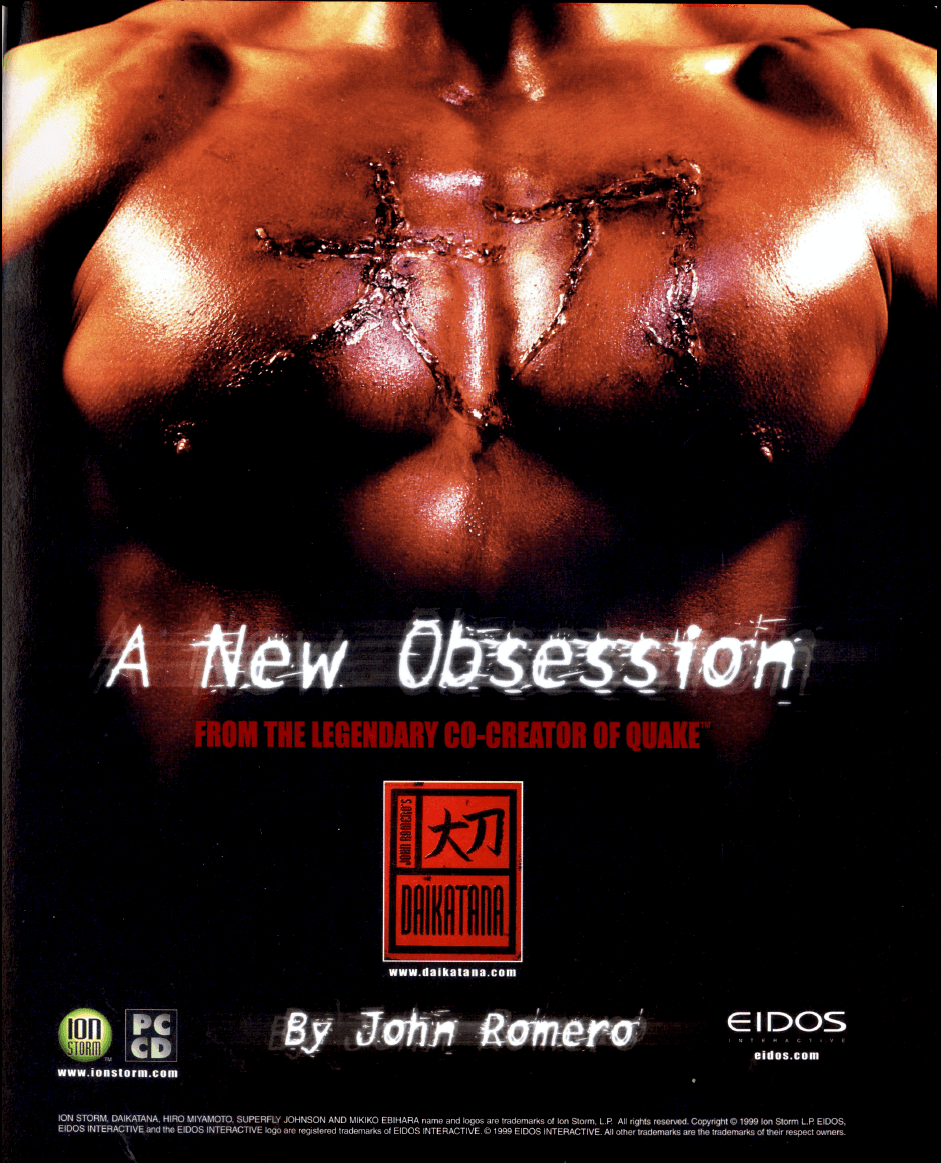
![Image For Post | **Development**
Daikatana was in development for 3 years, exactly. The reason for the long development cycle was the switch to the Quake II engine. Romero decided to switch because of its colored lighting, among other graphical goodies, but when he finally received the source code, it was nothing like he pictured. Overall the story of the game's development and Ion Storm in general is as epic and profound as anything in the game.
The game was built using the original Quake game engine; according to an early interview, Romero planned Daikatana to have unique weapon sets and 16 monsters per time period. The core concept was to do something different with shooter mechanics several times within the same game.[6] Romero created the basic storyline, and named its protagonist Hiro Miyamoto in honour of Japanese game designer Shigeru Miyamoto. The title is written in Japanese kanji, translating roughly to "big sword". The name comes from an item in a Dungeons & Dragons campaign played by the original members of id Software, which Romero co-founded.
During this early period, the team consisted of fifteen people. The music was composed by a team which included Will Loconto. However, during its earlier production, the team saw the Quake II engine and decided to incorporate its code. This resulted in many delays when finalising the engine. The problems with programming the new engine contributed to the game being delayed from its projected 1998 release date.[5] Romero stated prior to release that he would have chosen the Quake II engine to develop the game from the start if given the chance.
Romero later ascribed some problems triggered in using the technology as being due to the rivalry manufactured by the company's marketing between them and id Software. Due to the delays, development of the game ran parallel to Anachronox, Dominion: Storm Over Gift 3, and eventually Deus Ex.
Something that further impacted production was the departure of around twenty staff members from the team, who either left Ion Storm or transferred to the Austin studio. In 1998, lead artist Bryan Pritchard left the company and was replaced by Eric Smith. According to staff member Chrstian Divine, the growing negative press surrounding the company had a further detrimental effect on development. Some of the backlash eventually led to his own departure for Ion Storm's Austin studio to work on Deus Ex.
The most notorious incident was the public resignation of nine core team members at once, something Romero understood given the low team morale but felt it as a betrayal of trust. The departures led to the hiring of Stevie Case as level designer and Chris Perna to polish and add to character models. In a 1999 interview, Romero attributed the slowing of development during that period to the staff departures, but said that most of the level design and the entire score had been completed before that. Problems reached the point that Eidos publishing director John Kavanagh was sent down to sort out problems surrounding it production.
In a later interview, Romero admitted there were many faults with the game at release, blaming the development culture and management clashes at Ion Storm, in addition to staff departures causing much of the work to be scrapped and begun over again. Divine attributed the problems to a combination of overly carefree atmosphere, and corporate struggles about company ownership interfering with game production. Only two staff members remained on the game for the entirety of its production.](https://cdn.imgchest.com/files/we4gdcjkv4r.jpg)
